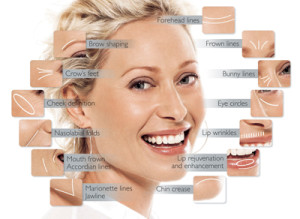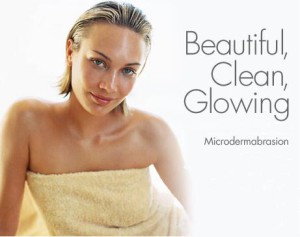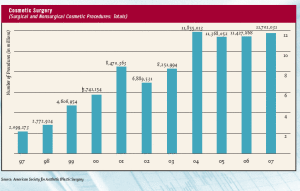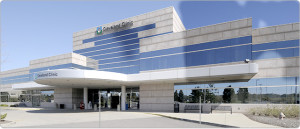 According to the American Society of Plastic Surgeons, cosmetic plastic surgery includes surgical and nonsurgical procedures that reshape normal structures of the body in order to improve appearance and self-esteem. Healthy individuals with a positive outlook and realistic expectations are appropriate candidates for cosmetic procedures. Plastic surgery is a personal choice and should be done for yourself, not to fulfill someone else’s desires or to try to fit an ideal image. Because it is elective, cosmetic surgery is usually not covered by health insurance.
According to the American Society of Plastic Surgeons, cosmetic plastic surgery includes surgical and nonsurgical procedures that reshape normal structures of the body in order to improve appearance and self-esteem. Healthy individuals with a positive outlook and realistic expectations are appropriate candidates for cosmetic procedures. Plastic surgery is a personal choice and should be done for yourself, not to fulfill someone else’s desires or to try to fit an ideal image. Because it is elective, cosmetic surgery is usually not covered by health insurance.
While any cosmetic surgery may seem vain, many people say these treatments have improved their lives. For example, South Korea has the highest ratio of procedures per capita. Surgeons in the Asian country perform around 20 procedures per 1,000 people. It has been estimated that between one-fifth and one-third of women in Seoul have gone under the knife, and one poll reported by the BBC puts the figure at fifty percent or higher for women in their twenties. The U.S. ranks second on a per capita basis, with 13 procedures per 1,000. Japan places third with 10 procedures per 1,000, according to numbers from the society.
Here are some of the top 8 cosmetic surgery procedures in high demand:
1. Breast augmentation surgery, also known as augmentation mammoplasty, is the surgical placement of breast implants to increase fullness and improve symmetry of the breasts, or to restore breast volume lost after weight reduction or pregnancy. Breast augmentation surgery involves using breast implants or fat, referred to as fat transfer breast augmentation, to increase the size of your breasts or restore breast volume that has been lost after weight reduction or pregnancy.
2. Surgical body contouring following major weight loss removes excess sagging fat and skin while improving the shape of the underlying support tissue. The result is a more normal appearance with smoother contours. Dramatic weight loss has many benefits. But after weight reduction surgery, or any substantial amount of weight loss, the skin and tissues often lack the elasticity to conform to the reduced body size. Body contouring procedures may include:
• Facelift: sagging of the mid-face, jowls, and neck, • Breast lift: sagging, flattened breasts; • Tummy tuck: apron of excess skin hanging over the abdomen, • Lower body lifts: sagging of the abdomen, buttocks, groin and outer thighs, • Medial thigh lift: sagging of the inner, outer and mid thigh, and • Arm lift: sagging of the upper arm
3. Rhinoplasty (“nose job”) can improve the appearance and proportion of your nose, or correct a breathing problem associated with the nose. Rhinoplasty surgery can change:
• Nose size in relation to facial balance, • Nose width at the bridge or in the size and position of the nostrils, • Nose profile with visible humps or depressions of the bridge, • Nasal tip that is enlarged or bulbous, drooping, upturned or hooked, • Nostrils that are large, wide, or upturned, • Nasal asymmetry
4. Dermal fillers: As we age, our faces naturally lose subcutaneous fat. The facial muscles are then working closer to the skin surface, so smile lines and crow’s feet become more apparent. The facial skin also stretches a bit, adding to this loss of facial volume. Other factors that affect the facial skin include sun exposure, heredity, and lifestyle. Injectable dermal fillers can plump thin lips, enhance shallow contours, soften facial creases, remove wrinkles and improve the appearance of recessed scars. Dermal fillers can also help to diminish facial lines and restore volume and fullness in the face.
5. Laser hair removal: is a non-invasive technique that uses highly concentrated light to penetrate hair follicles and inhibit future hair growth. Laser hair removal is effective for most parts of the body. But, because it only affects actively growing hair follicles, it may take several laser hair removal treatments to provide significant hair reduction. Additionally, while laser hair removal effectively slows hair growth, it doesn’t guarantee permanent hair removal. Periodic maintenance treatments may be needed.
 6. Microdermabrasion treatments use a minimally abrasive instrument to gently sand your skin, removing the thicker, uneven outer layer. Collagen is a protein in your skin that’s abundant when you’re a child and makes skin appear taut and smooth. Collagen production declines as we age, resulting in looser, uneven skin. Microdermabrasion helps to thicken your collagen, which results in a younger looking complexion. This type of skin rejuvenation is used to:
6. Microdermabrasion treatments use a minimally abrasive instrument to gently sand your skin, removing the thicker, uneven outer layer. Collagen is a protein in your skin that’s abundant when you’re a child and makes skin appear taut and smooth. Collagen production declines as we age, resulting in looser, uneven skin. Microdermabrasion helps to thicken your collagen, which results in a younger looking complexion. This type of skin rejuvenation is used to:
• Improve age spots and blackheads, • Improve hyperpigmentation (patches of darkened skin, • Exfoliate your skin, Resulting in a refreshed appearance, • Lessen the appearance of stretch marks, • Reduce fine lines and wrinkles, • Reduce or eliminate enlarged pores, • Treat acne and the scars left by acne.
7. Surgical hair transplantation involves removing small pieces of hair-bearing scalp grafts from a donor site and relocating them to a bald or thinning area. Techniques include punch grafts, mini-grafts, micro-grafts, slit grafts and strip grafts for a more modest change in hair fullness. Flaps, tissue-expansion and scalp-reduction are procedures best for patients who desire a more dramatic change.Baldness is often blamed on poor circulation to the scalp, vitamin deficiencies, dandruff, and even excessive hat-wearing. All of these theories have been disproved. It’s also untrue that hair loss can be determined by looking at your maternal grandfather, or that 40-year-old men who haven’t lost their hair will never lose it. But, here’s the truth about hair loss: Hair loss is primarily caused by a combination of: • Age, • Change in hormones, • Family history of baldness.
If you and your doctor have determined that hair transplants are the best option for you, you can feel comfortable knowing that board-certified plastic surgeons have been successfully performing this type of procedure for more than thirty years.
8. Ear surgery – also known as otoplasty – can improve the shape, position or proportion of the ear. It can correct a defect in the ear structure that is present at birth, or it can treat misshapen ears caused by injury. Ear surgery creates a natural shape, while bringing balance and proportion to the ears and face. Correction of even minor deformities can have profound benefits to appearance and self-esteem. Specifically, ear surgery can treat:
• Overly large ears– a rare condition called Macrotia, • Protruding ears occurring on one or both sides in varying degrees- not associated with hearing loss, and • Adult dissatisfaction with previous ear surgery.


